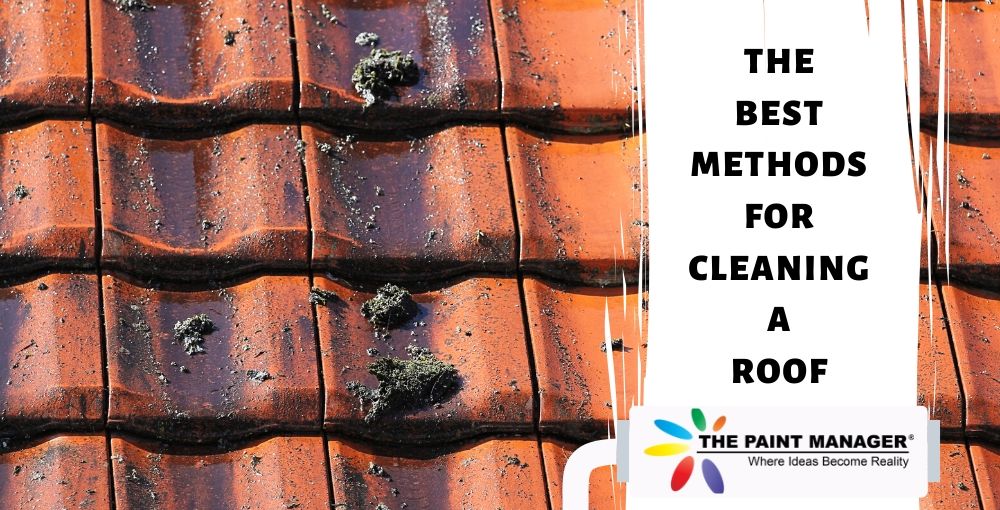A clean roof not only boosts the curb appeal of your home, it helps extend the life of the roof itself. Because the roof is exposed to harsh weather conditions, regular maintenance is necessary. Central Florida roofs, in particular, are susceptible to moss and algae growth due to the state’s high humidity. For those who are able to do the job themselves, here are the best expert-recommended methods for safe, effective cleaning.
Because we at The Paint Manager always emphasize safety first, we offer this caution. Any task that involves climbing a ladder or walking on a roof should only be done by physically sturdy people in good health, using the appropriate equipment and protective clothing. And it should not be your first time doing this type of work. If you’re an experienced do-it-yourself who successfully performs heavy home repairs and remodeling projects, or rehabs residential properties for rent or sale, this is in your wheelhouse. If you expect to learn to do this by watching YouTube videos, hire a pro. Our December blog post will focus on how to hire a roof cleaning contractor who has the right experience, credentials and business ethics.
Still with us? Then read on!
Removing algae and moss
As previously mentioned, Florida’s humid climate makes roofs susceptible to the growth of moss and algae. According to the Asphalt Roofing Manufacturers Association, it’s important to know what moss and algae really are, and how they spread.
“Often mistaken as mold or mildew, the black discoloration and streaks visible on many roofs across the United States and Canada are actually algae. The algae can form where moisture tends to dwell on roof surfaces. Coastal or humid climates create the most conducive conditions for algae growth. The most common type, gloeocapsa magma or blue green algae, protects itself from damaging ultraviolet rays by producing a dark pigmented sheath. The algae discoloration typically begins as small spots then quickly transforms into streaks on the roof plane. By the time the algae is visible, it likely has been present for several months or longer.”
Home restoration pioneer Bob Vila provides the following step-by-step instructions for removing moss.
Hose off the affected area with water, and then scrub the moss loose from the rooftop (shingles) – Before climbing the ladder, make sure you are wearing old clothes, slip-resistant shoes, gloves and eye protection. Place the ladder near the affected growth area and with a downward angle, hose off the area with water. Next, take a soft-bristle scrub brush with a long handle and rub gently to remove the moss and algae. Ensure that you scrub from the top down to avoid lifting shingles. Also, avoid scraping, scouring and pounding on the roof, and work in a small area so that shingles remain intact. Using a pressure washer is not recommended, as the force of the water can damage shingles.
Next, apply a cleaning solution – At times, scrubbing alone cannot remove the moss and algae. You can buy a commercial solution or make your own. As Villa advises, “Keep in mind that both commercial and homemade spray cleansers can damage sensitive plants and discolor siding, decks, or pathways, so you may want to spread plastic sheeting below your work area before you get started.
Some popular cleaning solutions include Bayer 2-in-1 Moss and Algae Killer and Wet & Forget that help remove mold, moss, and mildew. You can buy them from online stores or home improvement stores. Carefully follow all manufacturer’s instructions and cautions.
You can also make your own moss remover in a large spray bottle with one of these four DIY recipes:
- 8 ounces Dawn Ultra dish soap + 2 gallons of water
- 1 pound powdered oxygen bleach + 2 gallons of water
- 1½ to 3½ cups chlorine bleach + 2 gallons of water
- 1½ to 3½ cups white distilled vinegar + 2 gallons of water
For any of these homemade options, wet down the roof with plain water first, then apply the cleanser and let sit for 20 to 45 minutes. Lightly scrub with a soft-bristle brush, then rinse with water.
To prevent moss and algae regrowth
By being proactive, you don’t have to let nature eventually take its course again. Install strips of zinc or copper on the roof. These minerals naturally inhibit moss and algae growth. Apply strips of zinc- or copper-coated sheet metal just below the top ridge on both sides of the roof. Copper is more toxic to moss and algae, but zinc is less expensive. You can buy sheet metal in rolls and cut it into two- to four-inch strips. Attach the strips to the roof using roofing nails or screws with a rubber washer.
Also prune any tree limbs that overhang the roof—natural sunlight is a powerful moss preventive. In hurricane-prone Florida, this is an excellent safety measure anyway!
Next month, as promised, we will cover what to look for when hiring a roof cleaning professional. If you’ve already decided that roof cleaning is best left to the pros, The Paint Manager is ready! Our team has years of experience in cleaning every type of roofing material for both residential and commercial properties to provide the best possible results. You can also contact us for innovative ideas on painting and repainting your home’s interiors and exteriors — as well as providing a wide range of other services. We offer free estimates on all projects, and will be happy to help you take your home improvement plans to reality!

